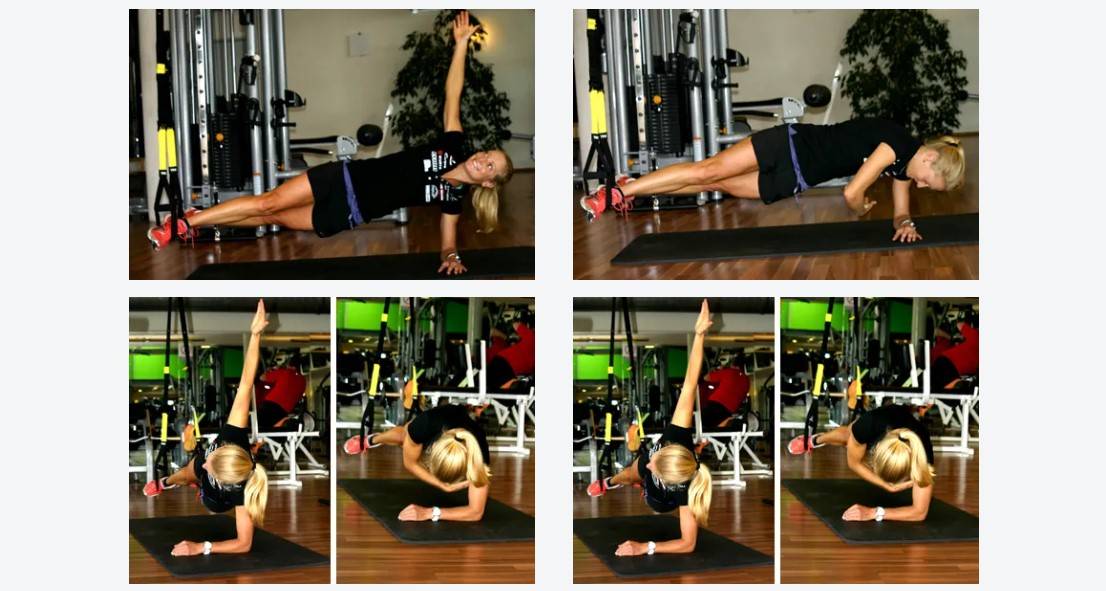TRX - hinter den drei Buchstaben verbergen sich zwei Schlingen, viel Schweiß und ordentlich Muskelkater. Beim TRX Training werden vor allem Muskelketten trainiert, das macht das Übungen in kurzer Zeit unglaublich effektiv. TRX Schlingentrainer sind daher aus den Fitnessstudios nicht mehr wegzudenken, aber auch eine schöne Trainingsalternative zum "klassischen" Stabi-Training für zu Hause oder im Trainingslager.
Platzmangel und Zeitnot im Einsatz ließen einen US Navy Seal kaum Möglichkeiten, sich optimal fit zu halten. Der findige Sportler ersann eine einfache Lösung: Eine Kombination aus Gürteln und Fallschirm-Gurtbändern diente ihm, um ein effektives Trainingsgerät zu konstruieren. Im Bereich der Physiotherapie ist die Wirksamkeit von Schlingen zur Rehabilitation seit langem bekannt. Mittlerweile haben aber auch Sportler das simple Trainingsgerät für sich entdeckt. Ausgebildete Trainer vermitteln in vielen Studios die richtige Handhabung und das Know-how für ein effektives Training.
Überall einsetzbar
Der Vorteil der Schlingen ist klar. Fast überall lässt sich das Trainingsgerät befestigen. Ob zu Hause oder auf Reisen. Wäre es nach Heidi Sessner gegangen, hätten wir die Übungen vor Strandkulisse an einer Palme absolviert. Vergeblich suchten wir nach dieser Location und mussten uns stattdessen mit dem Fitnessstudio begnügen. Der Anstrengung tat das jedoch keinen Abbruch. Ähnlich wie beim herkömmlichen Athletiktraining sind einige Übungen statisch und werden „nur“ gehalten. Andere Übungen sind hingegen dynamisch und werden mehrfach hintereinander ausgeführt.
Übung 1: Die Kniebeuge
Das wird trainiert: Gesäßmuskulatur, Rumpfmuskulatur, Beine
So geht’s: Ausgangsposition ist die gewohnte Laufbewegung. Der Fuß des Schwungbeines wird in die Schlinge gelegt. Nun wird eine einbeinige Kniebeuge ausgeführt. In der tiefsten Position ist der Oberschenkel parallel zum Boden. Der Fuß in der Schlinge bewegt sich dabei nach hinten. In die Ausgangsposition zurückkehren und Übung wiederholen.
Zu beachten: Kniebeuge nicht zu tief ausführen.
Übung 2: Der Unterarmstütz
Das wird trainiert: Rumpfmuskulatur, Bauchmuskulatur, Rückenmuskulatur
So geht’s: Füße in die knapp über dem Boden hängenden Schlaufen einhängen. In den Unterarmstütz gehen und den Körper parallel zum Boden halten.
Zu beachten: Die Oberarme befinden sich in rechtem Winkel zum Körper. Der Körper ist und bleibt gerade – kein Hohlkreuz oder Buckel machen.
Übung 3: Beine schwingen im Unterarmstütz
Das wird trainiert: Gesäßmuskulatur, Rumpfmuskulatur, Beine
So geht’s: Füße in die knapp über dem Boden hängenden Schlaufen einhängen. In den Unterarmstütz gehen und den Körper parallel zum Boden halten. Die Füße zusammenhalten und den Körper kontrolliert nach rechts schieben. Zur Mitte zurückkehren und die Übung zur anderen Seite wiederholen.
Zu beachten: Die Oberarme befinden sich in rechtem Winkel zum Körper. Der Körper ist und bleibt gerade – kein Hohlkreuz oder Buckel machen.
Übung 4: Klappmesser
Das wird trainiert: Bauchmuskulatur, Rumpfmuskulatur
So geht’s: Füße in die knapp über dem Boden hängenden Schlaufen einhängen. In den Unterarmstütz gehen und den Körper parallel zum Boden halten. Die Füße bei gestreckten Beinen nach vorne ziehen. Es entsteht fast ein rechter Winkel zwischen Beinen und Oberkörper.
Zu beachten: Die Knie bleiben durchgestreckt.
Übung 5: Drei Schritte-Übung
Das wird trainiert: Rumpfmuskulatur, Bauchmuskulatur
So geht’s: Füße in die knapp über dem Boden hängenden Schlaufen einhängen. In den bekannten Unterarmstütz gehen und den Körper parallel zum Boden halten. Von der liegen Position werden die Arme nacheinander ausgestreckt aufgestützt. Dann die Knie zu den Armen ziehen. Die Übungsfolge rückwärts bis zur Ausgangsposition schließen.
Zu beachten: Langsame und kontrollierte Bewegungen ausführen. Der Rumpf bleibt gerade und verwindet sich nicht.
Übung 6: Seitliche Bauchmuskulatur
Das wird trainiert: Rumpfmuskulatur, seitliche Bauchmuskulatur
So geht’s: Füße in die knapp über dem Boden hängenden Schlaufen einhängen. Arme schulterbreit aufstellen. Die zusammengepressten Knie nun Richtung linken Ellenbogen ziehen. In die Ausgangsposition zurückkehren und die Übung auf die rechte Seite wiederholen.
Zu beachten: Langsame und kontrollierte Bewegungen ausführen.
Übung 7: Der Seitstütz mit Drehung
Das wird trainiert: Rumpfmuskulatur, seitliche Bauchmuskulatur
So geht’s: Die Schlaufen befinden sich knapp über dem Boden. Füße zur Seite gedreht einhängen und hintereinander platzieren. Den Arm unter der Schulter aufstützen und den Rumpf vom Boden heben. Der andere Arm wird Richtung Decke gestreckt. Nun den oberen Arm unter die Brust führen. Der Oberkörper macht dabei eine rund 90° Drehung.
Zu beachten: Beine und Oberkörper befinden sich in einer Linie. Es entsteht kein Knick im Rumpfbereich.
Übung 8: Beckenheben
Das wird trainiert: Rumpfmuskulatur, seitliche Bauchmuskulatur
So geht’s: Die Schlaufen befinden sich knapp über dem Boden. Versen in die Schlaufen einhängen. Auf dem Rücken liegend wird das Gesäß und der untere Rücken vom Boden gehoben. Dabei liegen die Arme neben dem Körper entspannt am Boden. Nun werden die Versen Richtung Gesäß gezogen.
Zu beachten: Oberschenkel und Oberkörper befinden sich in einer Linie. Es entsteht kein Knick im Rumpfbereich.
Übung 9: Liegestütz
Das wird trainiert: Brustmuskulatur, Rumpfmuskulatur, Arme
So geht’s: Die Griffe des TRX Trainers werden bei ausgestreckten Armen etwa in Brusthöhe vor dem Körper gefasst. Auf den Zehenspitzen stehend werden die Ellenbogen angewinkelt. Danach wieder in die Ausgangsposition zurückkehren und die Übung wiederholen.
Zu beachten: Der Körper bildet von Verse zum Kopf eine Linie. Nicht ins Hohlkreuz fallen oder einen Buckel machen.
Übung 10: Butterfly
Das wird trainiert: Obere Rückenmuskulatur, Rumpfmuskulatur, Arme
So geht’s: Die Griffe des TRX Trainers werden bei ausgestreckten Armen etwa in Brusthöhe vor dem Körper gefasst. Nun den Körper zu den Griffen heranziehen. In die Ausgangsposition zurückkehren.
Zu beachten: Der Körper bildet von Verse zum Kopf eine Linie. Nicht ins Hohlkreuz fallen oder einen Buckel machen.




















